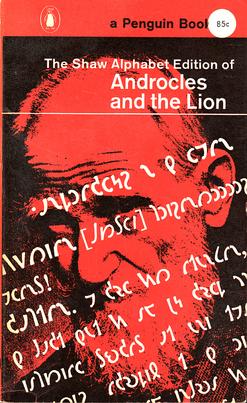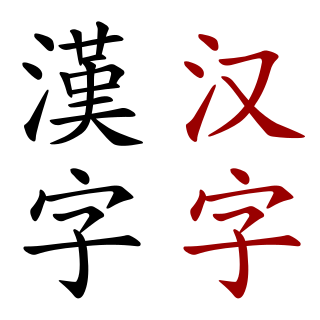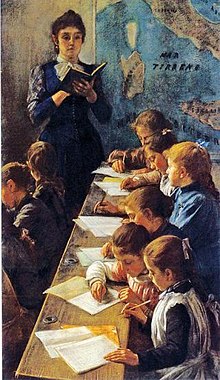
An alphabet is a standard set of letters written to represent particular sounds in a spoken language. Specifically, letters correspond to phonemes, the categories of sounds that can distinguish one word from another in a given language. Not all writing systems represent language in this way: a syllabary assigns symbols to spoken syllables, while logographies assign symbols to words, morphemes, or other semantic units.
Morphophonology is the branch of linguistics that studies the interaction between morphological and phonological or phonetic processes. Its chief focus is the sound changes that take place in morphemes when they combine to form words.
An orthography is a set of conventions for writing a language, including norms of spelling, hyphenation, capitalization, word boundaries, emphasis, and punctuation.

The Shavian alphabet is a constructed alphabet conceived as a way to provide simple, phonemic orthography for the English language to replace the inefficiencies and difficulties of conventional spelling using the Latin alphabet. It was posthumously funded by and named after Irish playwright George Bernard Shaw.
A spelling reform is a deliberate, often authoritatively sanctioned or mandated change to spelling rules. Proposals for such reform are fairly common, and over the years, many languages have undergone such reforms. Recent high-profile examples are the German orthography reform of 1996 and the on-off Portuguese spelling reform of 1990, which is still being ratified.

Hanja, alternatively known as Hancha, are Chinese characters used in the writing of Korean. Hanja was used as early as the Gojoseon period under the first Korean kingdom.

In linguistics, romanization is the conversion of text from a different writing system to the Roman (Latin) script, or a system for doing so. Methods of romanization include transliteration, for representing written text, and transcription, for representing the spoken word, and combinations of both. Transcription methods can be subdivided into phonemic transcription, which records the phonemes or units of semantic meaning in speech, and more strict phonetic transcription, which records speech sounds with precision.
A phonemic orthography is an orthography in which the graphemes correspond to the language's phonemes. Natural languages rarely have perfectly phonemic orthographies; a high degree of grapheme–phoneme correspondence can be expected in orthographies based on alphabetic writing systems, but they differ in how complete this correspondence is. English orthography, for example, is alphabetic but highly nonphonemic; it was once mostly phonemic during the Middle English stage, when the modern spellings originated, but spoken English changed rapidly while the orthography was much more stable, resulting in the modern nonphonemic situation. On the contrary the Albanian, Serbian/Croatian/Bosnian/Montenegrin, Romanian, Italian, Turkish, Spanish, Finnish, Czech, Latvian, Esperanto, Korean and Swahili orthographic systems come much closer to being consistent phonemic representations.
The Vietnamese alphabet is the modern writing script for Vietnamese. It uses the Latin script based on Romance languages originally developed by Portuguese missionary Francisco de Pina (1585–1625).

Many East Asian scripts can be written horizontally or vertically. Chinese characters, Korean hangul, and Japanese kana may be oriented along either axis, as they consist mainly of disconnected logographic or syllabic units, each occupying a square block of space, thus allowing for flexibility for which direction texts can be written, be it horizontally from left-to-right, horizontally from right-to-left, vertically from top-to-bottom, and even vertically from bottom-to-top.
Vietnamese literature is the literature, both oral and written, created largely by the Vietnamese. Early Vietnamese literature has been greatly influenced by Chinese literature. As Literary Chinese was the formal written language for government documents, a majority of literary works were composed in Hán văn or as văn ngôn. From the 10th century, a minority of literary works were composed in chữ Nôm, the former writing system for the Vietnamese language. The Nôm script better represented Vietnamese literature as it led to the creation of different poetic forms like Lục bát and Song thất lục bát. It also allowed for Vietnamese reduplication to be used in Vietnamese poetry.
According to the alphabetic principle, letters and combinations of letters are the symbols used to represent the speech sounds of a language based on systematic and predictable relationships between written letters, symbols, and spoken words. The alphabetic principle is the foundation of any alphabetic writing system. In the education field, it is known as the alphabetic code.

Korean mixed script is a form of writing the Korean language that uses a mixture of the Korean alphabet or hangul and hanja, the Korean name for Chinese characters. The distribution on how to write words usually follows that all native Korean words, including suffixes, particles, and honorific markers are generally written in hangul and never in hanja. Sino-Korean vocabulary or hanja-eo, either words borrowed from Chinese or created from Sino-Korean roots, were generally always written in hanja, although very rare or complex characters were often substituted with hangul. Although the Korean alphabet was introduced and taught to people beginning in 1446, most literature until the early twentieth century was written in literary Chinese known as hanmun.

The Chinese family of scripts includes writing systems used to write various East Asian languages, that ultimately descend from the oracle bone script invented in the Yellow River valley during the Shang dynasty. These include written Chinese itself, as well as adaptations of it for other languages, such as Japanese kanji, Korean hanja, Vietnamese chữ Hán and chữ Nôm, Zhuang sawndip, and Bai bowen. More divergent are the Tangut script, Khitan large script, Khitan small script and its offspring, the Jurchen script, as well as the Yi script, Sui script, and Geba syllabary, which were inspired by written Chinese but not descended directly from it. While written Chinese and many of its descendant scripts are logographic, others are phonetic, including the kana, Nüshu, and Lisu syllabaries, as well as the bopomofo semi-syllabary.
The traditional periodization of Korean distinguishes:

A writing system comprises a particular set of symbols, called a script, as well as the rules by which the script represents a particular language. Writing systems can generally be classified according to how symbols function according to these rules, with the most common types being alphabets, syllabaries, and logographies. Alphabets use symbols called letters that correspond to spoken phonemes. Abjads generally only have letters for consonants, while pure alphabets have letters for both consonants and vowels. Abugidas use characters that correspond to consonant–vowel pairs. Syllabaries use symbols called syllabograms to represent syllables or moras. Logographies use characters that represent semantic units, such as words or morphemes.
Vietnamese poetry originated in the form of folk poetry and proverbs. Vietnamese poetic structures include Lục bát, Song thất lục bát, and various styles shared with Classical Chinese poetry forms, such as are found in Tang poetry; examples include verse forms with "seven syllables each line for eight lines," "seven syllables each line for four lines", and "five syllables each line for eight lines." More recently there have been new poetry and free poetry.

The Korean alphabet, known as Hangul in South Korea and Chosŏn'gŭl in North Korea, is the modern official writing system for the Korean language. The letters for the five basic consonants reflect the shape of the speech organs used to pronounce them, and they are systematically modified to indicate phonetic features; similarly, the vowel letters are systematically modified for related sounds, making Hangul a featural writing system. It has been described as a syllabic alphabet as it combines the features of alphabetic and syllabic writing systems.

Chữ Hán is the term for Chinese characters in Vietnamese. Chữ Hán are used to write Literary Chinese and Sino-Vietnamese vocabulary in the Vietnamese language. They were officially used in Vietnam after the Red River Delta region was incorporated into the Han dynasty and continued to be used until the early 20th century where usage of Literary Chinese was abolished alongside the Confucian court examinations causing chữ Hán to fall into obscurity.










